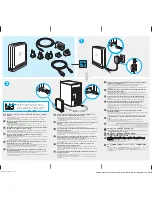
Installation - Windows
Mixbus on Windows uses an industry-standard installation mechanism. Follow the directions for a “Typical” install to
install Mixbus, the documentation, and any accompanying materials.
After installation, please continue to
Download
and
Install the License File
, on the following pages.
Uninstalling Mixbus: use the uninstaller provided in the Windows Control Panel.
A note about JACK:
Jack is a system service that allows for the interconnection of audio between applications. Your Mixbus installation
on Windows
does not
require that you install JAC K separately. A simplified JACK (which is not visible to other
applications) is automatically installed when you install Mixbus.
If you would like to interconnect the audio of different applications into Mixbus, then you can download and install a
system-wide version of JACK. This is not endorsed or supported by Harrison at this time.
A note about “Audio Setup” on Windows:
On Windows, Mixbus will detect soundcards that use the DirectSound or ASIO API. This means that you will likely
see soundcards appear multiple times in the audio setup menus. If provided, the ASIO driver option is preferable for
stable, low-latency operation.
Many built-in desktop sound devices will not provide an “Input device” if a microphone is not physically plugged in. If
you plan to record with Mixbus, you must plug a device into the soundcard’s input _before_ you launch the audio
engine. If you’d like to use Mixbus without a capture device, choose “None” for the Input device. Mixbus does not
provide a “None” option for the playback device. If you have no devices for playback then you can choose the
Dummy device which runs Mixbus without any sound I/O.
When you select an ASIO device, the “Buffer size” setting will be automatically changed to the current preferred
buffersize of your ASIO device (normally set in the device’s manufacturer-supplied control panel). It is important to
use the device’s preferred buffersize. Otherwise you will incur a “buffersize adaptation” process which reduces effi-
ciency and may affect latency (delay) through Mixbus.
Non-ASIO devices will default to a buffersize of 1024 for stable operation. Changing this setting is possible but is
unlikely to have much effect on the performance because of the Windows sound infrastructure.
A note about VST plugins on Windows:
On Windows, Mixbus will load and use VST plugins. Please note that we cannot guarantee that all 3rd party plugins
will work properly in Mixbus. Mixbus is (currently) a 32-bit only application on Windows, so it can only load 32-bit
VST plugins.
When you launch the Plugin Manager for the first time, Mixbus will prompt you to scan for VST plugins. This process
can take several minutes if you have many plugins. If the scan completes succesfully, then Mixbus will auto-scan for
plugins when it starts up in the future. This process is much faster than the initial scan.
If a plugin causes Mixbus to crash during the “scan” procedure, then this plugin will be placed on a “blacklist” which
prevents that version of the plugin from loading in the future.
Please see the Preferences->Plugin dialog for more information about VST plugins.
3
3..0
0 IIn
ns
st
ta
alllla
at
tiio
on
n
5






































